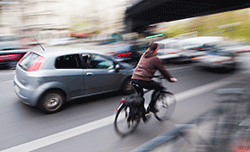This litigation has concluded and we are proud to report that our clients' claims have been successfully resolved. The amounts of all individual client recoveries are confidential, both by settlement agreement and by attorney-client privilege. MLG is no longer accepting cases involving this product.
Published on Wednesday, May 11, 2016 by Amos Brumble

This is also a very common scenario when traveling on a bicycle. Due to your lower speed, drivers will generally be passing you frequently. It is when they also need to make a right turn into a side street or driveway that the danger occurs. Longer vehicles such as large trucks and vehicles with trailers leave larger blind spots for the driver and take longer to complete a turn. Complicating situations is a driver's perception that you are traveling much slower that you really are – giving the driver the mistaken belief that he/she has more time and space to make the right-hand turn across your pathway.
This situation is similar to when oncoming cars turn into your path.
Again very similar to the situation where an oncoming vehicle is turning into your path. The first step is to recognize this dangerous situation. A place a driver could go and the signs that the driver is turning. Similarly riding two to three feet from the edge is key so you stand out and have some room to maneuver your bike. A solid working tail light is helpful. Avoid wearing anything that blocks your hearing and be mindful of what is happening around you. A good old fashion mirror either helmet mounted, bar mounted or on the glasses are inexpensive ways to see behind you without looking over your shoulder and swerving around all the time. On the technology front there are a wave of rear view cameras and radar like devices that can mount to your bike to warn of approaching vehicles.
At this point the driver is turning and you must assume that they have not seen you.
Next up, Drivers Merging into or Crossing Your Pathway from Intersecting Streets or Driveways.
This litigation has concluded and we are proud to report that our clients' claims have been successfully resolved. The amounts of all individual client recoveries are confidential, both by settlement agreement and by attorney-client privilege. MLG is no longer accepting cases involving this product.